Equations of Lines
Learning Outcomes
- Use slope-intercept form to plot and write equations of lines.
- Use point-slope form to write the equation of a line.
- Write the equation of a line in standard form.
- Recognize vertical and horizontal lines from their graphs and equations.
- Determine whether two lines are parallel or perpendicular.
- Find the equations of parallel and perpendicular lines.
- Write the equations of lines that are parallel or perpendicular to a given line.
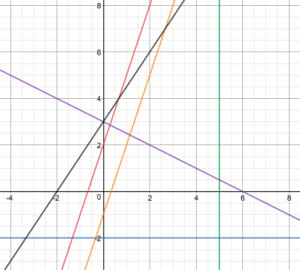 (a) [latex]y=3x+2[/latex]
(b) [latex]y-4=-\frac{1}{2}(x+2)[/latex]
(c) [latex]x=5[/latex]
(d) [latex]y=-2[/latex]
(e) [latex]3x=y+1[/latex]
(f) [latex]2y-3x=6[/latex]
(a) [latex]y=3x+2[/latex]
(b) [latex]y-4=-\frac{1}{2}(x+2)[/latex]
(c) [latex]x=5[/latex]
(d) [latex]y=-2[/latex]
(e) [latex]3x=y+1[/latex]
(f) [latex]2y-3x=6[/latex]
Writing Equations of Lines
Slope-Intercept Form
Perhaps the most familiar form of a linear equation is slope-intercept form written as [latex]y=mx+b[/latex], where [latex]m=\text{slope}[/latex] and [latex]b=y\text{-intercept}[/latex]. Let us begin with the slope.The Slope of a Line
The slope of a line refers to the ratio of the vertical change in y over the horizontal change in x between any two points on a line. It indicates the direction in which a line slants as well as its steepness. Slope is sometimes described as rise over run.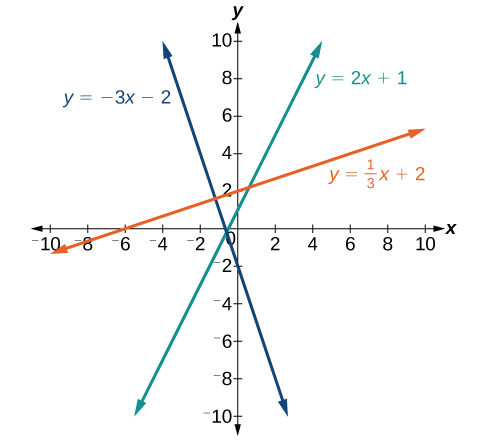
A General Note: The Slope of a Line
The slope of a line, m, represents the change in y over the change in x. Given two points, [latex]\left({x}_{1},{y}_{1}\right)[/latex] and [latex]\left({x}_{2},{y}_{2}\right)[/latex], the following formula determines the slope of a line containing these points:Example: Finding the Slope of a Line Given Two Points
Find the slope of a line that passes through the points [latex]\left(2,-1\right)[/latex] and [latex]\left(-5,3\right)[/latex].Answer: We substitute the y-values and the x-values into the formula.
Analysis of the Solution
It does not matter which point is called [latex]\left({x}_{1},{y}_{1}\right)[/latex] or [latex]\left({x}_{2},{y}_{2}\right)[/latex]. As long as we are consistent with the order of the y terms and the order of the x terms in the numerator and denominator, the calculation will yield the same result.Try It
Find the slope of the line that passes through the points [latex]\left(-2,6\right)[/latex] and [latex]\left(1,4\right)[/latex].Answer: slope[latex]=m=\dfrac{-2}{3}=-\dfrac{2}{3}[/latex]
Example: Identifying the Slope and y-intercept of a Line Given an Equation
Identify the slope and y-intercept given the equation [latex]y=-\frac{3}{4}x - 4[/latex].Answer: As the line is in [latex]y=mx+b[/latex] form, the given line has a slope of [latex]m=-\frac{3}{4}[/latex]. The y-intercept is [latex]b=-4[/latex].
Analysis of the Solution
The y-intercept is the point at which the line crosses the y-axis. On the y-axis, [latex]x=0[/latex]. We can always identify the y-intercept when the line is in slope-intercept form, as it will always equal b. Or, just substitute [latex]x=0[/latex] and solve for y.The Point-Slope Form
Given the slope and one point on a line, we can find the equation of the line using point-slope form.A General Note: The Point-Slope Formula
Given one point and the slope, using point-slope form will lead to the equation of a line:Example: Finding the Equation of a Line Given the Slope and One Point
Write the equation of the line with slope [latex]m=-3[/latex] and passing through the point [latex]\left(4,8\right)[/latex]. Write the final equation in slope-intercept form.Answer: Using point-slope form, substitute [latex]-3[/latex] for m and the point [latex]\left(4,8\right)[/latex] for [latex]\left({x}_{1},{y}_{1}\right)[/latex].
Analysis of the Solution
Try It
Given [latex]m=4[/latex], find the equation of the line in slope-intercept form passing through the point [latex]\left(2,5\right)[/latex].Answer: [latex-display]y=4x - 3[/latex-display]
Example: Finding the Equation of a Line Passing Through Two Given Points
Find the equation of the line passing through the points [latex]\left(3,4\right)[/latex] and [latex]\left(0,-3\right)[/latex]. Write the final equation in slope-intercept form.Answer: First, we calculate the slope using the slope formula and two points.
Analysis of the Solution
Standard Form of a Line
Another way that we can represent the equation of a line is in standard form. Standard form is given asExample: Finding the Equation of a Line and Writing It in Standard Form
Find the equation of the line with [latex]m=-6[/latex] and passing through the point [latex]\left(\frac{1}{4},-2\right)[/latex]. Write the equation in standard form.Answer: We begin by using point-slope form.
Try It
Find the equation of the line in standard form with slope [latex]m=-\frac{1}{3}[/latex] which passes through the point [latex]\left(1,\frac{1}{3}\right)[/latex].Answer: [latex]x+3y=2[/latex]
Vertical and Horizontal Lines
The equations of vertical and horizontal lines do not require any of the preceding formulas, although we can use the formulas to prove that the equations are correct. The equation of a vertical line is given as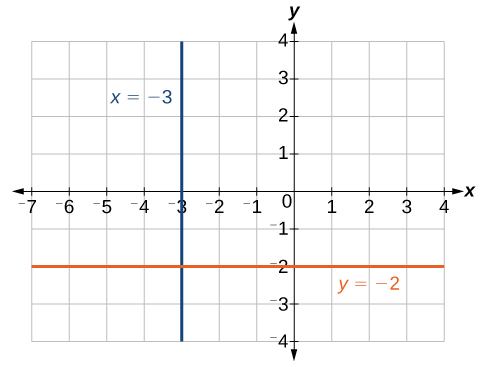 The line x = −3 is a vertical line. The line y = −2 is a horizontal line.
The line x = −3 is a vertical line. The line y = −2 is a horizontal line.Example: Finding the Equation of a Line Passing Through the Given Points
Find the equation of the line passing through the given points: [latex]\left(1,-3\right)[/latex] and [latex]\left(1,4\right)[/latex].Answer: The x-coordinate of both points is 1. Therefore, we have a vertical line, [latex]x=1[/latex].
Try It
Find the equation of the line passing through [latex]\left(-5,2\right)[/latex] and [latex]\left(2,2\right)[/latex].Answer: Horizontal line: [latex]y=2[/latex]
Parallel and Perpendicular Lines
Parallel lines have the same slope and different y-intercepts. Lines that are parallel to each other will never intersect. For example, the figure below shows the graphs of various lines with the same slope, [latex]m=2[/latex].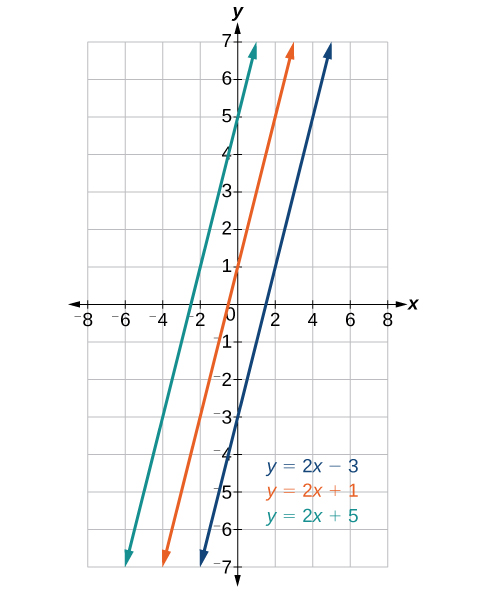 Parallel lines have slopes that are the same.
Parallel lines have slopes that are the same.[latex]\begin{array}{l}\text{ }{m}_{1}\cdot {m}_{2}=-1\hfill \\ \text{ }3\cdot \left(-\frac{1}{3}\right)=-1\hfill \end{array}[/latex]
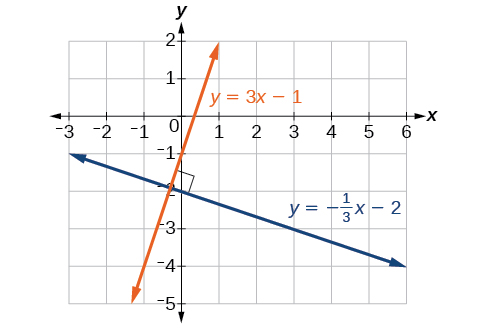 Perpendicular lines have slopes that are negative reciprocals of each other.
Perpendicular lines have slopes that are negative reciprocals of each other.Example: Graphing Two Equations and Determining Whether the Lines are Parallel, Perpendicular, or Neither
Graph the equations of the given lines and state whether they are parallel, perpendicular, or neither: [latex]3y=-4x+3[/latex] and [latex]3x - 4y=8[/latex].Answer: The first thing we want to do is rewrite the equations so that both equations are in slope-intercept form. First equation:
[latex]\begin{array}{l}3y=-4x+3\hfill \\ y=-\frac{4}{3}x+1\hfill \end{array}[/latex]
Second equation:[latex]\begin{array}{l}3x - 4y=8\hfill \\ -4y=-3x+8\hfill \\ y=\frac{3}{4}x - 2\hfill \end{array}[/latex]
See the graph of both lines in the graph below. From the graph, we can see that the lines appear perpendicular, but we must compare the slopes.
From the graph, we can see that the lines appear perpendicular, but we must compare the slopes.
[latex]\begin{array}{l}{m}_{1}=-\frac{4}{3}\hfill \\ {m}_{2}=\frac{3}{4}\hfill \\ {m}_{1}\cdot {m}_{2}=\left(-\frac{4}{3}\right)\left(\frac{3}{4}\right)=-1\hfill \end{array}[/latex]
The slopes are negative reciprocals of each other confirming that the lines are perpendicular.Try It
Graph the two lines and determine whether they are parallel, perpendicular, or neither: [latex]2y-x=10[/latex] and [latex]2y=x+4[/latex].Answer:
Parallel lines. Write the equations in slope-intercept form.

Writing Equations of Parallel Lines
Suppose we are given the following equation:[latex]y=3x+1[/latex]
We know that the slope of the line formed by the function is 3. We also know that the y-intercept is (0, 1). Any other line with a slope of 3 will be parallel to [latex]y=3x+1[/latex]. So all of the following lines will be parallel to the given line.[latex]\begin{array}{lll}y=3x+6\hfill & \\ y=3x+1\hfill & \\ y=3x+\frac{2}{3}\hfill \end{array}[/latex]
Suppose then we want to write the equation of a line that is parallel to [latex]y=3x+6[/latex] and passes through the point (1, 7). We already know that the slope is 3. We just need to determine which value for b will give the correct line. We can begin with point-slope form of a line and then rewrite it in slope-intercept form.[latex]\begin{array}{llll}y-{y}_{1}=m\left(x-{x}_{1}\right)\hfill & \\ y - 7=3\left(x - 1\right)\hfill & \\ y - 7=3x - 3\hfill & \\ \text{}y=3x+4\hfill \end{array}[/latex]
So [latex]y=3x+4[/latex] is parallel to [latex]y=3x+1[/latex] and passes through the point (1, 7).How To: Given the equation of a LINE, write the equation of a line parallel to the given line that passes through A given point
- Find the slope of the line.
- Substitute the given values into either point-slope form or slope-intercept form.
- Simplify.
Example: Finding a Line Parallel to a Given Line
Find a line parallel to the graph of [latex]y=3x+6[/latex] that passes through the point (3, 0).Answer: The slope of the given line is 3. If we choose to use slope-intercept form, we can substitute m = 3, x = 3, and y = 0 into slope-intercept form to find the y-intercept.
[latex]\begin{array}{lll}y=3x+b\hfill & \\ \text{}0=3\left(3\right)+b\hfill & \\ \text{}b=-9\hfill \end{array}[/latex]
The line parallel to [latex]y=3x+6[/latex] that passes through (3, 0) is [latex]y=3x - 9[/latex].Analysis of the Solution
We can confirm that the two lines are parallel by graphing them. The graph below shows that the two lines will never intersect.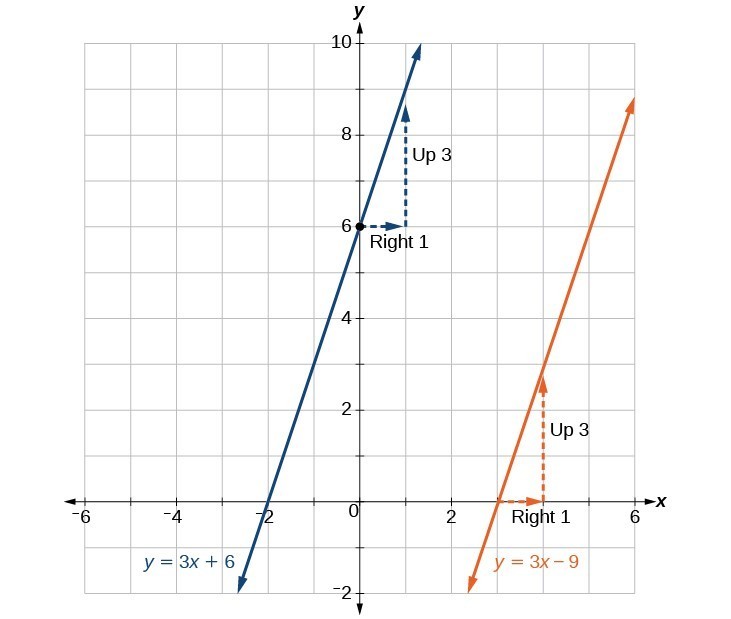
Writing Equations of Perpendicular Lines
We can use a very similar process to write the equation for a line perpendicular to a given line. Instead of using the same slope, however, we use the negative reciprocal of the given slope. Suppose we are given the following line:[latex]y=2x+4[/latex]
The slope of the line is 2 and its negative reciprocal is [latex]-\frac{1}{2}[/latex]. Any function with a slope of [latex]-\frac{1}{2}[/latex] will be perpendicular to [latex]y=2x+4[/latex]. So all of the following lines will be perpendicular to [latex]y=2x+4[/latex].[latex]\begin{array}{lll}y=-\frac{1}{2}x+4\hfill & \\ y=-\frac{1}{2}x+2\hfill & \\ y=-\frac{1}{2}x-\frac{1}{2}\hfill \end{array}[/latex]
As before, we can narrow down our choices for a particular perpendicular line if we know that it passes through a given point. Suppose then we want to write the equation of a line that is perpendicular to [latex]y=2x+4[/latex] and passes through the point (4, 0). We already know that the slope is [latex]-\frac{1}{2}[/latex]. Now we can use the point to find the y-intercept by substituting the given values into slope-intercept form and solving for b.[latex]\begin{array}{lllll}y=mx+b\hfill & \\ 0=-\frac{1}{2}\left(4\right)+b\hfill & \\ 0=-2+b\hfill \\ 2=b\hfill & \\ b=2\hfill \end{array}[/latex]
The equation for the function with a slope of [latex]-\frac{1}{2}[/latex] and a y-intercept of 2 is [latex]y=-\frac{1}{2}x+2[/latex]. So [latex]y=-\frac{1}{2}x+2[/latex] is perpendicular to [latex]y=2x+4[/latex] and passes through the point (4, 0). Be aware that perpendicular lines may not look obviously perpendicular on a graphing calculator unless we use the square zoom feature.Q & A
A horizontal line has a slope of zero and a vertical line has an undefined slope. These two lines are perpendicular, but the product of their slopes is not –1. Doesn’t this fact contradict the definition of perpendicular lines? No. For two perpendicular linear functions, the product of their slopes is –1. As you will learn later, a vertical line is not a function so the definition is not contradicted.How To: Given the equation of a LINE, write the equation of a line Perpendicular to the given line that passes through A given point
- Find the slope of the given line.
- Determine the negative reciprocal of the slope.
- Substitute the slope and point into either point-slope form or slope-intercept form.
- Simplify.
Example: Finding the Equation of a Perpendicular Line
Find the equation of a line perpendicular to [latex]y=3x+3[/latex] that passes through the point (3, 0).Answer: The original line has slope m = 3, so the slope of the perpendicular line will be its negative reciprocal or [latex]-\frac{1}{3}[/latex]. Using this slope and the given point, we can find the equation for the line.
[latex]\begin{array}y=-\frac{1}{3}x+b\hfill & \\ \text{}0=-\frac{1}{3}\left(3\right)+b\hfill & \\ \text{}1=b\hfill \\ \text{ }b=1\hfill \end{array}[/latex]
The line perpendicular to [latex]y=3x+3[/latex] that passes through (3, 0) is [latex]y=-\frac{1}{3}x+1[/latex].Analysis of the Solution
A graph of the two lines is shown below.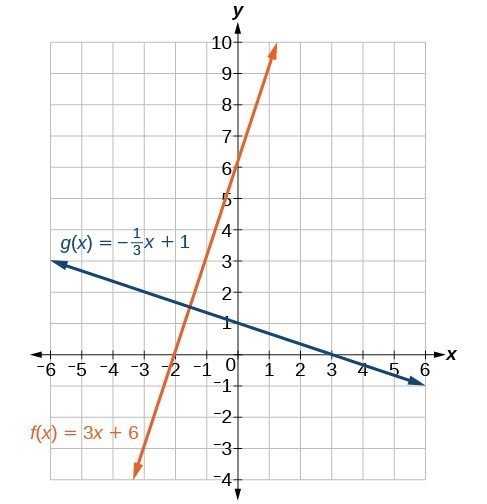
Try It
Given the line [latex]y=2x - 4[/latex], write an equation for the line passing through (0, 0) that is- parallel to y
- perpendicular to y
Answer:
- [latex]y=2x[/latex] is parallel
- [latex]y=-\frac{1}{2}x[/latex] is perpendicular
How To: Given two points on a line, write the equation of A perpendicular line that passes through A Third point
- Determine the slope of the line passing through the points.
- Find the negative reciprocal of the slope.
- Substitute the slope and point into either point-slope form or slope-intercept form.
- Simplify.
Example: Finding the Equation of a Perpendicular Line
A line passes through the points (–2, 6) and (4, 5). Find the equation of a perpendicular line that passes through the point (4, 5).Answer: From the two points of the given line, we can calculate the slope of that line.
[latex]\begin{array}{lll}{m}_{1}=\frac{5 - 6}{4-\left(-2\right)}\hfill & =\frac{-1}{6}\hfill & =-\frac{1}{6}\hfill \end{array}[/latex]
Find the negative reciprocal of the slope.[latex]\begin{array}{lll}{m}_{2}=\frac{-1}{-\frac{1}{6}}\hfill & =-1\left(-\frac{6}{1}\right)\hfill & =6\hfill \end{array}[/latex]
We can then solve for the y-intercept of the line passing through the point (4, 5).[latex]\begin{array}{lllll}y=6x+b\hfill \\ 5=6\left(4\right)+b\hfill \\ 5=24+b\hfill \\ -19=b\hfill \\ b=-19\hfill \end{array}[/latex]
The equation for the line that is perpendicular to the line passing through the two given points and also passes through point (4, 5) is:[latex]y=6x - 19[/latex]
Try It
A line passes through the points (–2, –15) and (2, –3). Find the equation of a perpendicular line that passes through the point (6, 4).Answer: [latex]y=-\frac{1}{3}x+6[/latex]
Writing the Equations of Lines Parallel or Perpendicular to a Given Line
As we have learned, determining whether two lines are parallel or perpendicular is a matter of finding the slopes. To write the equation of a line parallel or perpendicular to another line, we follow the same principles as we do for finding the equation of any line. After finding the slope, use point-slope form to write the equation of the new line.Example: Writing the Equation of a Line Parallel to a Given Line
Write the equation of line parallel to a [latex]5x+3y=1[/latex] which passes through the point [latex]\left(3,5\right)[/latex].Answer: First, we will write the equation in slope-intercept form to find the slope.
[latex]\begin{array}{l}5x+3y=1\hfill \\ 3y=-5x+1\hfill \\ y=-\frac{5}{3}x+\frac{1}{3}\hfill \end{array}[/latex]
The slope is [latex]m=-\frac{5}{3}[/latex]. The y-intercept is [latex]\frac{1}{3}[/latex], but that really does not enter into our problem, as the only thing we need for two lines to be parallel is the same slope. The one exception is that if the y-intercepts are the same, then the two lines are the same line. The next step is to use this slope and the given point in point-slope form.[latex]\begin{array}{l}y - 5=-\frac{5}{3}\left(x - 3\right)\hfill \\ y - 5=-\frac{5}{3}x+5\hfill \\ y=-\frac{5}{3}x+10\hfill \end{array}[/latex]
The equation of the line is [latex]y=-\frac{5}{3}x+10[/latex].
Try It
Find the equation of the line parallel to [latex]5x=7+y[/latex] which passes through the point [latex]\left(-1,-2\right)[/latex].Answer: [latex]y=5x+3[/latex]
Example: Finding the Equation of a Perpendicular Line
Find the equation of the line perpendicular to [latex]5x - 3y+4=0[/latex] which goes through the point [latex]\left(-4,1\right)[/latex].Answer: The first step is to write the equation in slope-intercept form.
[latex]\begin{array}{l}5x - 3y+4=0\hfill \\ -3y=-5x - 4\hfill \\ y=\frac{5}{3}x+\frac{4}{3}\hfill \end{array}[/latex]
We see that the slope is [latex]m=\frac{5}{3}[/latex]. This means that the slope of the line perpendicular to the given line is the negative reciprocal or [latex]-\frac{3}{5}[/latex]. Next, we use point-slope form with this new slope and the given point.[latex]\begin{array}{l}y - 1=-\frac{3}{5}\left(x-\left(-4\right)\right)\hfill \\ y - 1=-\frac{3}{5}x-\frac{12}{5}\hfill \\ y=-\frac{3}{5}x-\frac{12}{5}+\frac{5}{5}\hfill \\ y=-\frac{3}{5}x-\frac{7}{5}\hfill \end{array}[/latex]
Key Concepts
- Given two points, we can find the slope of a line using the slope formula.
- We can identify the slope and y-intercept of an equation in slope-intercept form.
- We can find the equation of a line given the slope and a point.
- We can also find the equation of a line given two points. Find the slope and use point-slope form.
- The standard form of a line has no fractions.
- Horizontal lines have a slope of zero and are defined as [latex]y=c[/latex], where c is a constant.
- Vertical lines have an undefined slope (zero in the denominator) and are defined as [latex]x=c[/latex], where c is a constant.
- Parallel lines have the same slope and different y-intercepts.
- Perpendicular lines have slopes that are negative reciprocals of each other unless one is horizontal and the other is vertical.
Glossary
- slope
- the change in y-values over the change in x-values
Licenses & Attributions
CC licensed content, Original
- Revision and Adaptation. Provided by: Lumen Learning License: CC BY: Attribution.
CC licensed content, Shared previously
- College Algebra. Provided by: OpenStax Authored by: Abramson, Jay et al.. Located at: https://openstax.org/books/college-algebra/pages/1-introduction-to-prerequisites. License: CC BY: Attribution. License terms: Download for free at http://cnx.org/contents/[email protected].
- Question ID 1719. Authored by: Barbara Goldner. License: CC BY: Attribution. License terms: IMathAS Community License CC- BY + GPL.
- Question ID 110942, 110946, 110951, 110952, 110960, 110970, 110971. Authored by: Lumen Learning. License: CC BY: Attribution. License terms: IMathAS Community License CC-BY + GPL.
- Question ID 1436. Authored by: WebWork-Rochester. License: CC BY: Attribution. License terms: IMathAS Community License CC- BY + GPL.
CC licensed content, Specific attribution
- College Algebra. Provided by: OpenStax Authored by: OpenStax College Algebra. License: CC BY: Attribution.
